Bees on flowers
Bees in nature
Bees in defferent habitats
PUBLISHED
WORKS
Bees near Bor
Bees in nature
PUBLISHED ARTICLES
Nucleus
Beequeens marking
Wax moth
UP TO DATE
Honeybees protection
Reproductive nucleus
![]() back
back
HONEYBEES IN NATURE – BIO INDICATORS OF LIVING ENVIRONMENT CONDITION
Ivan Brndušić – Beekeepers
association "Albina" Bor
Toplica Marjanović – RTB TIR Bor
ABSTRACT
Phenomenon of honeybees in Bor surrounding was observed seven years ago. Surveying of this phenomenon has started two years ago and till now 79 societies of honeybees was found and filed in trees’ cavities, chimneys, bridges and rock cavities.
In this article, descriptions of some abiotic, biotic and anthropogenic factors, which have the influence on honey bees, are given. In article is included review of pollution levels in Bor area caused by exploitation and processing of copper ore.Results of honey analysis are shown and compared with similar results from other parts of the country and other countries.
Are bees indicators of living environment pollution and in which measure? Answer on this question can be given by further studies of honeybees firstly on their representative residences.
INTRODUCTION
At the beginning of the eighties, in Bor had been exploited and processed copper ore with increased arsenic content. Concentration of arsenic in the atmosphere of Bor area was from 1,9 to 3,69 mg/m3 of the air.
Researches had shown that concentrations like this has been the cause of massive death of bees.
Ending of that ore body exploitation has
caused decreasing of arsenic concentration in living environment. In the summer of 1989
bees population colonies in bridge on the road Bor-Zaječar, at the entrance of Bor, was
observed.Informations about honeybees societies became more frequent and, in the last two
years, the systematic research of this phenomenon has started.
METHODS AND WORK RESULTS
To the independent (solitary) bees living in nature, till now, considerable attention was neither paid nor results of scientific and specialist researches of this phenomenon exist.
Evidence of honeybees started with beekeepers and local residents reports.Each bees – society has been recorded on separate card with basic data about society itself and its residence and also about health conditions of bees, all documented by suitable photo and video material. Till now, 79 bees- societies of honeybees is filed, but much mere had been reported.
Geomorphologic relief shapes are important ecological factor. Height above sea level of the filed bees residences is about 250 to 500 m. Direction of the hills extension in Bor surrounding is North – South, and honeybees residences were found mostly on East (39 societies) and West (30 societies) sides of the hills, which is shown on the table 1 and figures 1 and 2.
In surrounding of Bor, there mostly meadow-and-wood kinds of ecological systems and ground under agricultural plants.
The most frequent honeybees residences area in rarefied woods or on their edges (49 societies) and on meadows (14 societies). Bees were founded in the old houses of urban settlements near black locust woods (Table 2 and Figures 3 and 4).
Bees have been mostly settled in the old trees cavities (70 societies) but there is also very interesting phenomenon of their settlement in chimneys, which were not in use during summer or in long period of time (Table 3; Figures 5 and 6).
According to the copper Institute measurements, sulphurdioxide (SO2) concentrations, sediment materials and dust hanging in the air in the last two years were lower than at the beginning of the eighties. They were increased only in Brestovačka spa, which has been cause by new built city settlement. For the purpose of heating, boiler room was built , and, also, individual means of heating were used, causing the increase of air pollution in winter season.
Arsenic concentrations were highly decreased, which is of extreme importance for the life of bees.
In Table 4., selected indicators of air
pollution level in Bor area are shown as average values for the observed period of time,
based on the results of daily and monthly conducted measurements. 3)
Table 4. Emission of sulphurdioxide, dust, arsenic and sediment materials in air of Bor
region for the periods 1979-1989 and 1992-1994.
PERIOD |
POINT |
SO BOR |
INSTITUT |
ELEKTRO ISTOK |
BRESTOVAČKA SPA |
JEZERO |
GORNJANE |
ZLOT |
| AIR STRUCTURE | ||||||||
| 1979 | SO2 (µg/m3) | 173 |
89 |
323 |
16 |
84 |
- |
- |
| DUST (µg/m3) |
- | 828 |
354 |
112 |
257 |
- |
- |
|
| - | ARSEN (ng/m3) | 1900 - 3600 |
30 |
60 |
- |
1500 |
||
| 1982 | SEDIMENT
MATERIALS (mg/m2/day) |
359 |
120 |
323 |
72 |
84 |
- |
- |
| 1992 | SO2 (µg/m3) | 162 |
68 |
145 |
41 |
88 |
- |
- |
| DUST (µ g/m3) |
731 |
539 |
642 |
111 |
104 |
- |
- |
|
| - | ARSEN (ng/m3) | 90 |
25 |
122 |
64 |
43 |
7 |
0 |
| 1994 | SEDIMENT MATERIALS (mg/m2/day) |
270 |
147 |
162 |
103 |
115 |
- |
- |
Systematic probing of honey on content of particular, for humans harmful materials and hard metals, in our country are not usual. For the purpose of these researchings, honey was collected in Bor surroundings and compared with honey taken form beekeepers in Osanica (Žagubica), Metriš (Negotin) and Gamzigrad. Results of these analysis are given in Table 5. and compared with research results form 1986. in Yugoslavia, 4) and with research results in the USA, Wisconsin, 5).
Quantities of these materials in honey originated from Bor surroundings are within the limits stipulated by the quality regulations for honey and food, except in one sample taken in Tanda, in which the Zinc quantity was above permitted values. After visiting the place, it was established that honey was inadequate preserved in containers coated with zinc. Compared with domestic and researches made abroad, it can be concluded that content of copper, sulfur, zinc, nickel, cadmium and lead is mostly lower in honey taken in Bor area.
Table 5. Results of honey analysis
Cu |
Pb |
Cd |
Ni |
As |
Fe |
S |
Zn |
|
| BREZONIK | 0,13 |
<0,1 |
<0,02 |
0,10 |
<0,05 |
0,20 |
10,8 |
0,52 |
| TANDA | 0,14 |
<0,1 |
<0,02 |
0,74 |
<0,05 |
4,00 |
18,5 |
3,5 |
| BRESTOVAC | 0,13 |
<0,1 |
<0,02 |
0,23 |
<0,05 |
0,30 |
8,3 |
0,38 |
| SLATINA | 0,35 |
<0,1 |
<0,02 |
0,26 |
<0,05 |
0,79 |
14,0 |
1,8 |
| OSANICA | 0,24 |
<0,1 |
<0,02 |
0,18 |
<0,05 |
1,14 |
18,2 |
1,5 |
| METRIŠ | 0,17 |
<0,1 |
<0,02 |
0,24 |
<0,05 |
0,40 |
14,9 |
0,38 |
| GAMZIGRAD | 0,08 |
<0,1 |
<0,02 |
0,44 |
<0,05 |
0,40 |
8,8 |
0,73 |
| USA 5) | 0,29 |
- |
- |
0,29 |
- |
2,40 |
58 |
- |
| YUGOSLAVIA 4) | 0,25 |
0,37 |
0,06 |
- |
- |
4,72 |
- |
- |
FINAL DISCUSSIONS
By decreasing of emission of arsenic from smelter plants, one of the extremely important anthropogenic ecological factor is eliminated, previously causing the limitation of conditions for bees survival or their massive death.That is clear expressed by the data of increased number of honeybees and survival of their colonies for a long time in natural residences without human help.
Bees are mostly settled in cavities of trees in ecosystems of woods and meadows. They should be find in human settlements surrounded by woods of black locust or meadows.
Sulphurdioxide in high concentrations can not directly act on bees but damages on flora decrease the possibility of their survival. Sulphurdioxide has positive influence on fungus diseases of bees.In honeybees colonies the disease called "lime litter", very dangerous and frequent disease of bee-colonies, was not found.
Researches started have to be continued to determine in which extent bees can be indicators of living environment conditions. These researches have to be expanded with following:
Arsenic and hard metals content in flower powder of melliferous herbs. Arsenic and hard metals content in honey, pollen and propolis
Water quality of natural springs
Survey on representative honeybees colonies.Honeybees and their colonies deserve institutional protection.
COLONY EXPOSITION
SIDE |
NORTH |
EAST |
SOUTH |
WEST |
No of COLONY |
11 |
35 |
3 |
30 |
PERCENTAGE |
13,9 |
44,3 |
3,8 |
38,0 |
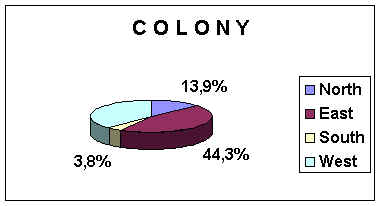
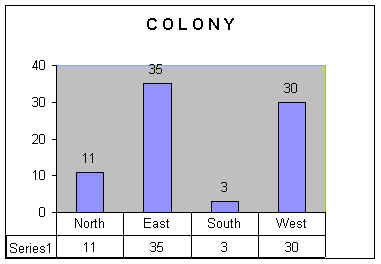
COLONY
COLONY |
WOOD |
FIELD |
SETTLEMENT |
No of COLONIS |
49 |
14 |
16 |
PERCENTAGE |
62,0 |
17,7 |
20,3 |
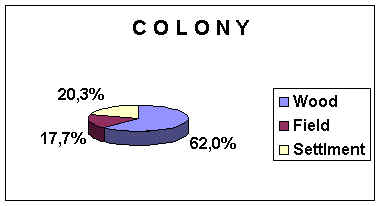
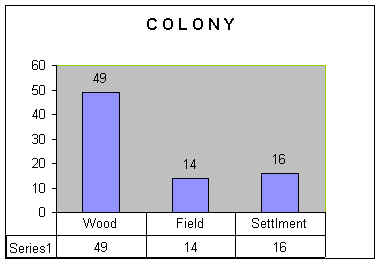
COLONY
COLONY |
CAVITY IN TREE |
CHEMNEY |
REST |
No of COLONIS |
70 |
4 |
5 |
PERCENT |
88,6 |
5,1 |
6,3 |
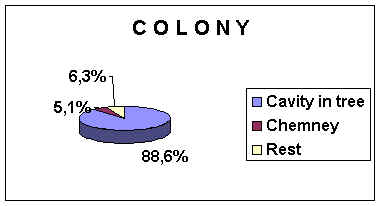
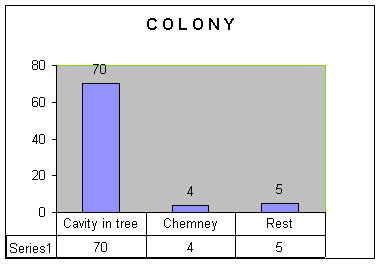
REFERENCES
1. Milošević, N. (1986): Emisija štetnih materija u komunalnoj sredini grada Bora, II simpozijum o zaštiti zdravlja radnika RTB Bor, Zbornik radova, str. 5-10, Bor.
2. Terzić, Lj., Terzić, V., (1989): Aerozagađivanje sa arsenom iz metalurških i topioničarskih postrojenja kao stalni uzorak uginuća medonosnih pčela, Čovek i životna sredina, br. 4-5/89, str. 84-87, Beograd.
3. Milošević,
N. i saradnici (1993-1994) Mesečni i godišnji izveštaji o kontroli zagađenosti vazduha u Boru za 1992., 1993., 1994. godinu, Institut za bakar Bor.4. Šovljanski, R. (1990): Kvalitet meda i zdravstvena ispravnost, Pčelar, br. 3/90, str. 81-06, Beograd.
5. Kulinčević, J. (1989): Minerali u medu, Pčelar, Beograd.
6. Pravilnik o kvalitetu meda i drugih pčelinjih proizvoda i metodama za kontrolu kvaliteta meda i drugih pčelinjih proizvoda, Sl. list SFRJ, 4/85., Beograd.
7. Pravilnik o količinama pesticida i drugih otrovnih materija, hormona, antibiotika mikotoksina koji se mogu nalaziti u životnim namirnicama, Sl. list SFRJ, br. 59/83, Beograd.
8. Brndušić, I. (1994): Pčele nastanjene divlje u okolini Bora, Zbornik saopštenja II naučno-stručnog skupa o prirodnim vrednostima i zaštiti životne sredine "Naša
ekološka istina", str. 145-146, Borsko jezero.